No DNA Damage Detected from Low-Dose CT Scans
Researchers identified significant DNA breaks and chromosome aberrations with standard-dose CT; no impact from low-dose scans.

Low-dose CT scans don’t cause any harm to human DNA, according to new research, but the conversation about the possible risks of radiation exposure continues to swirl.
Published in the March 10 issue of Radiology, researchers from Japan, led by Satoshi Tashiro, M.D., Ph.D., director of the Research Institute for Radiation Biology and Medicine at Hiroshima University, revealed they found exposure to low-dose CT has no effect on human DNA. In contrast, the team did identify DNA damage in patients who received standard-dose CT exams.
Since the National Lung Screening Trial published its results, low-dose CT scans have been the preferred screening method for high-risk patients, including long-time smokers. But, concerns over the actual impact of radiation exposure, even at low doses, have lingered. According to Tashiro, this is the first trial to examine the bodily impact in this way.
“There were no studies investigating the biological effect of low-dose CT scans on large numbers of patients,” he said. “These findings led us to investigate these effects.”
Despite being one-fourth the dose of a standard CT, a low-dose scan still presents a radiation-associated cancer risk. Consequently, investigating whether low-dose scans lead to DNA damage or chromosome aberrations carries clinical importance, he said.
For this study, Tashiro’s team compared DNA samples from 107 patients who underwent low-dose CT exams (mean effective dose 1.5 mSv), as well as 102 who had standard-dose CTs (5 mSv). Additionally, they collected blood samples both before and 15 minutes after the exams. Their analysis showed distinct differences between the groups.
“We could clearly detect the increase of DNA damage and chromosome aberrations after standard chest CT,” Tashiro said in a statement. “In contrast, no significant differences were observed in these biological effects before and after low-dose CT.”
Based on their results, the team identified a statistically significant increase in DNA double-strand breaks (p<0.001) and chromosome aberrations (p=0.003) in patients who received standard-dose CT scans. Investigators saw no similar statistically similar increases among low-dose recipients.
To further confirm that standard-dose CT caused more DNA damage than low-dose exams, the team analyzed samples from 63 participants who received a standard-dose follow-up exam three months after their initial low-dose scan. The second round validated the findings -- standard-dose CT led to statistically significant increases in DNA damage (p=0.01) and chromosome aberrations (p=0.009) in all individuals even though they had shown no statistically significant effects after the low-dose exams.
These results could, according to Tashiro’s statement, alleviate some of the concerns about potential increases in radiation-related cancer risks as they relate to screening programs.
“Even using these sensitive analyses, we could not detect the biological effects of low-dose CT scans,” he said. “This suggest that application of low-dose CT for lung cancer screening is justified from a biological point of view.”
However, David Brenner, Ph.D., director of the Columbia University Center for Radiological Research, cautioned that it might be too early to confirm low-dose CT scans pose no statistically significant risk of DNA damage. The true impact can only be determined, he said, if more patients are studied.
“Whereas the increased DNA damage was statistically significant in the standard CT dose group, the increase in the low CT dose group was smaller and no longer significant,” he wrote in an editorial accompanying the article published by Tashiro’s team. “This pattern reflects low-dose radiation epidemiologic studies of cancer risk, in which as the dose and the risk decrease, exponentially more participants are required in the study to achieve statistical significance.”
Ultimately, however, he added, the overwhelming benefit of CT to a patient who needs the exam far outweighs the small or, potentially zero, radiation risk.